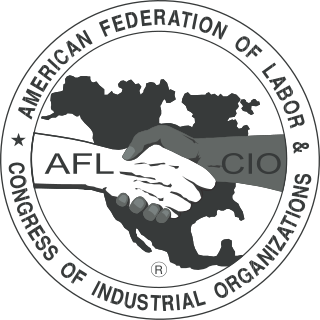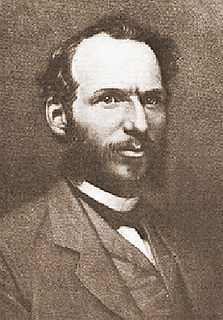The General Trades' Union was formed in New York City in 1833 with the purpose of uniting all of the trade societies of New York. The goal of this central union was to better coordinate the various trade unions in the New York City area, to provide assistance during conflicts with employers, and to maintain a fund for striking laborers. The GTU formed the National Trades Union, the first attempt at a nationwide union movement. The GTU of New York organised one the first strikes in the United States and initiated the system now known as collective bargaining.

The American Federation of Labor and Congress of Industrial Organizations (AFL-CIO) is the largest federation of unions in the United States. It is made up of fifty-five national and international unions, together representing more than 12 million active and retired workers. The AFL-CIO engages in substantial political spending and activism, typically in support of Democrats and liberal or progressive policies.

The American Federation of Labor (AFL) was a national federation of labor unions in the United States founded in Columbus, Ohio, in December 1886 by an alliance of craft unions disaffected from the Knights of Labor, a national labor union. Samuel Gompers of the Cigar Makers' International Union was elected president at its founding convention and reelected every year, except one, until his death in 1924. The A.F. of L was the largest union grouping in the United States for the first half of the 20th century, even after the creation of the Congress of Industrial Organizations (CIO) by unions which were expelled by the AFL in 1935 over its opposition to industrial unionism. The Federation was founded and dominated by craft unions throughout its first fifty years, after which many craft union affiliates turned to organizing on an industrial union basis to meet the challenge from the Congress of Industrial Organizations (CIO) in the 1940s.

The Federation of Organized Trades and Labor Unions of the United States and Canada (FOTLU) was a federation of labor unions created on November 15, 1881, at Turner Hall in Pittsburgh. It changed its name to the American Federation of Labor (AFL) on December 8, 1886.

Peter J. McGuire was an American labor leader of the nineteenth century. He co-founded the United Brotherhood of Carpenters and Joiners of America in 1881 along with Gustav Luebkert and became one of the leading figures in the first three decades of the American Federation of Labor. He is credited with first proposing the idea of Labor Day as a national holiday in 1882.

The Ceramic and Allied Trades Union (CATU) was a trade union representing pottery workers in the United Kingdom.
A labour council, trades council or industrial council is an association of labour unions or union branches in a given area. Most commonly, they represent unions in a given geographical area, whether at the district, city, region, or provincial or state level. They may also be based on a particular industry rather than geographical area, as for example, in the Maritime Council of Australia which co-ordinated the waterfront and maritime unions involved in the 1890 Australian Maritime Dispute.
The eight-hour day movement or 40-hour week movement, also known as the short-time movement, was a social movement to regulate the length of a working day, preventing excesses and abuses. It had its origins in the Industrial Revolution in Britain, where industrial production in large factories transformed working life. The use of child labour was common. The working day could range from 10 to 16 hours, and the work week was typically six days a week. Robert Owen had raised the demand for a ten-hour day in 1810, and instituted it in his socialist enterprise at New Lanark. By 1817 he had formulated the goal of the eight-hour day and coined the slogan: "Eight hours' labour, Eight hours' recreation, Eight hours' rest". Women and children in England were granted the ten-hour day in 1847. French workers won the 12-hour day after the February Revolution of 1848. A shorter working day and improved working conditions were part of the general protests and agitation for Chartist reforms and the early organisation of trade unions.
A Directly Affiliated Local Union (DALU) is a U.S. labor union that belongs to the AFL-CIO but is not a national union and is not entitled to the same rights and privileges within the Federation as national affiliates.

James Sinclair Taylor McGowen was an Australian politician and the first Labor Premier of New South Wales from 21 October 1910 to 30 June 1913.

Ely Moore was a Jacksonian U.S. Representative from New York (1835–1839).

The Seafarers International Union or SIU is an organization of 12 autonomous labor unions of mariners, fishermen and boatmen working aboard vessels flagged in the United States or Canada. Michael Sacco has been its president since 1988. The organization has an estimated 35,498 members and is the largest maritime labor organization in the United States. Organizers founded the union on October 14, 1938. The Seafarers International Union arose from a charter issued to the Sailors Union of the Pacific by the American Federation of Labor as a foil against loss of jobs to the Congress of Industrial Organizations (CIO) and its Communist Party-aligned faction.

The United Association of Journeymen and Apprentices of the Plumbing, Pipefitting and Sprinkler Fitting Industry of the United States and Canada is a labor union which represents workers in the plumbing and pipefitting industries in the United States and Canada.

James Duncan was a Scottish American union leader, and president of the Granite Cutters' International Association from 1885 until his death in 1928. He was an influential member of the American labor movement, helping to co-found the American Federation of Labor.
The Grand National Consolidated Trades Union of 1834 was an early attempt to form a national union confederation in the United Kingdom.

The Labor Council of New South Wales, branded Unions NSW, is the peak body for trade unions in the state of New South Wales, Australia. As of 2005 there are 67 unions and 8 Rural and Regional Trades & Labor Councils affiliated to the Labor Council, representing 800,000 workers in NSW. It is registered as the State Peak Council of Employees under Section 215 of the Industrial Relations Act 1996 (NSW). The Council is affiliated with the Australian Council of Trade Unions (ACTU).

William H. Sylvis (1828–1869) was a pioneer American trade union leader. Sylvis is best remembered as a founder of the Iron Molders' International Union and the National Labor Union, the latter being one of the first American union federations attempting to unite workers of various crafts into a single national organization.
The South African Industrial Federation was established in 1914 as an amalgamation of the Industrial Federations in the provinces of South Africa.
The South African Trades Union Council was established in 1925 as a result of a special congress after the collapse of the South African Industrial Federation called by the Minister of Labour, Colonel Cresswell. All the affiliated unions were registered under the Industrial Conciliation Act 1924 and represented white workers. It merged with the Cape Federation of Labour Unions in 1930, forming the South African Trades and Labour Council.
The National Trades Union was the first federation of city trade unions in the United States. It formed in 1834. Its main aim was the 10 hour day. It did not survive the panic of 1837.













